How to replace a ground drive belt on a riding lawn mower
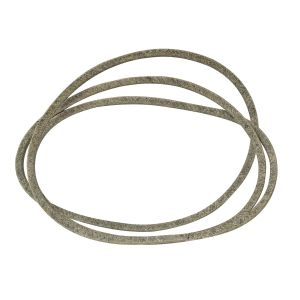
This DIY riding mower repair guide gives step-by-step instructions for replacing a ground drive belt on a riding lawn mower. The ground drive belt connects the engine crankshaft to the transaxle pulley to drive the rear wheels. If the belt breaks, the lawn tractor won't move. If the belt is worn, the lawn tractor moves sluggishly because the belt slips on the pulley. Examine the ground drive belt and replace it with a manufacturer-approved riding lawn mower part if it’s broken or excessively worn.
You can use this procedure on how to replace the drive belt on a Craftsman lawn mower to replace the same part on Toro, Troybilt, Husqvarna, MTD and Ariens lawn tractors and riding mowers.
This video explains how to replace the ground drive belt on a riding lawn mower.
Instructions
- 01.
Disconnect the spark plug
Park the tractor on a level surface and set the parking brake.
Turn the ignition switch off and remove the key.
Wear work gloves to protect your hands.
Lift the tractor hood and disconnect the spark plug wire.
Tip: Disconnect both spark plug wires if your tractor has 2 cylinders.
PHOTO: Disconnect the spark plug.
- 02.
Remove the mower deck
Lower the mower deck to its lowest position.
Disengage the cutting blades.
Roll the blade belt off the engine pulley and release the belt from the belt keepers.
Remove the front lift link support retaining pin and washer and then detach the support from the deck.
Remove the left suspension arm retaining clip and washer and then detach the arm from the tractor frame.
Remove the left rear deck bracket retaining clip and washer and then release the bracket from the deck.
Repeat the process on the other side of the deck to disconnect the right suspension arm and right rear deck bracket.
Pull the deck out far enough to access the blade cable attached to the deck.
Release the locking tabs and pull the blade cable out of the deck bracket.
Disconnect the blade cable spring from the idler arm and move the cable aside.
Pull the deck out from under the frame.
Tip: Warning: Because the spring-loaded attachment lift lever exerts more tension on the lever the after you disconnect the rear lift linksTip: don't use the lever until you reinstall the mower deck.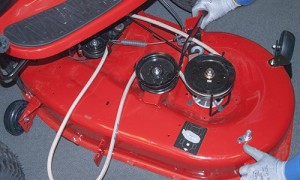
PHOTO: Pull out the mower deck.
- 03.
Remove the ground drive belt
Remove the flywheel screen cap and position a socket wrench on the flywheel bolt with the wrench handle resting against the fuel tank to keep the crankshaft from turning when you remove the engine pulley bolt.
Remove the engine pulley bolt and washer and then pull the engine pulley off the crankshaft.
Release the drive belt from the pulley.
Release the belt from the idler pulleys and belt guides.
Lift the seat remove the bolt connecting the negative cable to the battery.
Lift the insulating cover and remove the bolt connecting the positive cable to the battery.
Lift the battery out of the battery box.
Release the seat switch wire harness clip from the seat bracket to create slack in the harness.
Release retaining tabs and lift the battery box out of the tractor body.
Set the box on the fender.
Release the drive belt from the transaxle pulley.
Pull out the ground drive belt.
Tip: You can also keep the crankshaft from turning as you remove the engine pulley bolt by removing the spark plug and then stuffing nylon rope into the engine cylinder.Tip: If the old belt is still intact, take a photo of how the belt routes through the idler pulleys so you can route the new belt correctly. If the belt is broken, see the owner's manual for belt routing.Tip: Spray a rusted crankshaft bolt with penetrating oil so you can remove it easier.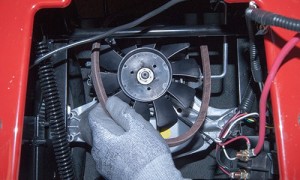
PHOTO: Release the belt from the transaxle pulley.
- 04.
Install the new ground drive belt
Loop the ground drive belt over the transaxle pulley.
Position the battery box in the opening and align the wire harness and battery cables.
Lower the battery box into the tractor body and engage the retaining tabs.
Connect the seat switch wire harness clip to the seat bracket.
With the insulating cover positioned on the cable, connect the positive battery cable to the positive battery terminal.
Connect the negative battery cable to the negative battery terminal.
Lower the seat.
Route the belt through the chassis and over the steering plate.
Push the belt through the inside of the front belt guides.
Loop the belt over the engine pulley, line up the pulley notch with the crankshaft groove and slide the engine pulley onto the crankshaft.
Position the wrench on the flywheel bolt so the wrench handle rests against the fuel tank to prevent crankshaft rotation as you reinstall the engine pulley bolt.
Install the engine pulley bolt and washer.
Remove the wrench from the flywheel bolt and reinstall the flywheel screen cap.
Using your photo as a guide, route the right side of the belt through the front and middle idler pulleys.
Slide the left side of the belt into the belt keeper and over the rear pulley.
Remove the rope from the engine cylinder and reinstall the spark plug.
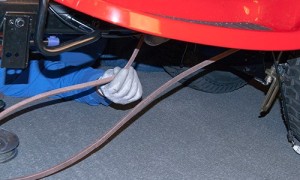
PHOTO: Install the ground drive belt.
- 05.
Reinstall the mower deck
Push the deck near the tractor frame.
Connect the blade clutch cable spring to the idler arm.
Push the blade clutch cable retainer into the deck bracket and engage the locking tabs.
Position the deck under the tractor frame.
Reconnect the front lift link support to the deck using the washer and retaining clip.
Reconnect the left suspension arm and deck bracket using the washers and retaining clips.
Repeat the process to reconnect the right suspension arm and deck bracket.
Route the blade belt through the belt keepers and roll the blade belt onto the engine pulley.
Check the blade belt routing on the mower deck and adjust the blade belt if needed to route the belt over all pulleys and through all belt keepers.
Tip: See your owner's manual for more on routing the blade belt.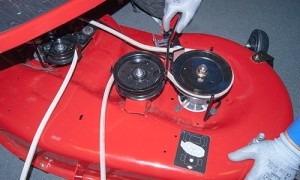
PHOTO: Reinstall the mower deck.
- 06.
Reconnect the spark plug
Reconnect the spark plug wire and lower the tractor hood.
Most common symptoms to help you fix your riding mowers & tractors
Choose a symptom to see related riding mower and lawn tractor repairs.
Main causes: worn or broken blade belt, broken belt idler pulley, blade clutch cable failure, bad PTO switch, damaged ma…
Main causes: faulty battery, bad alternator…
Main causes: punctured tire or inner tube, leaky valve stem, damaged wheel rim…
Main causes: dead battery, stale fuel, bad starter solenoid, ignition system problem, bad ignition interlock switch, clo…
Main causes: damaged tie rods, bent or worn wheel spindle, worn front axle, damaged sector gear assembly…
Main causes: shift lever needs adjustment, neutral control needs adjustment…
Main causes: clogged carburetor, damaged flywheel key, dirty spark plug, stale fuel, improper valve lash, engine needs a…
Main causes: worn or broken ground drive belt, bad seat switch, transaxle freewheel control engaged, transaxle failure, …
Main causes: unlevel mower deck, dull or damaged cutting blades, worn mandrel pulleys, bent mower deck, engine needs tun…
Most common repair guides to help fix your riding mowers & tractors
These step-by-step repair guides will help you safely fix what’s broken on your riding mower or lawn tractor.
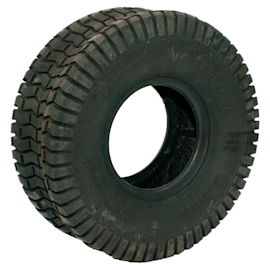
How to replace a riding lawn mower rear tire
Your mower can’t run on a damaged rear tire. Here’s how to install a new one.…
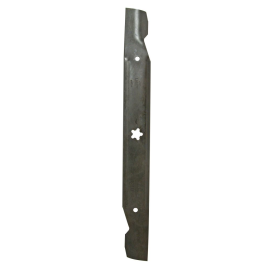
How to replace a riding lawn mower blade
If a blade on your mower is dull or bent, replace it following the steps in this repair guide.…
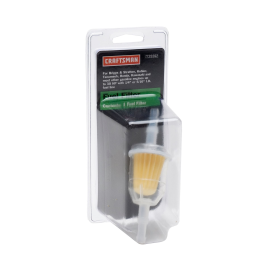
How to replace a riding lawn mower fuel filter
Help your mower run better by replacing the fuel filter during your riding mower's annual tune-up.…
Effective articles & videos to help repair your riding mowers & tractors
Use the advice and tips in these articles and videos to get the most out of your riding mower or lawn tractor.

Learn about all the convenient features on our Sears PartsDirect website that make your parts purchases easier.…

Get answers to frequently asked questions about Sears and Sears PartsDirect.…
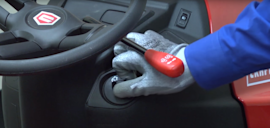
Check the starter solenoid, starter motor, wiring, battery and engine.…